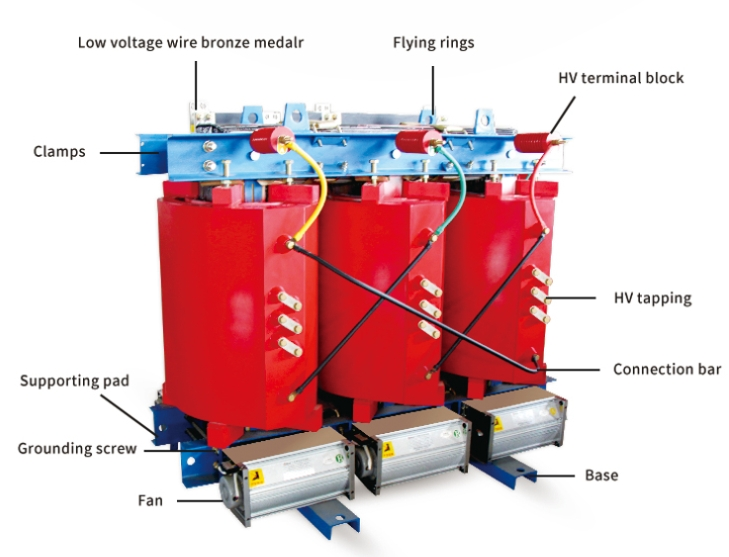Introduction
Definition of dry type transformer
Dry type transformer is electrical transformer that operates without the use of liquid coolant for insulation and cooling purposes. Unlike oil-immersed transformers, which rely on liquid oil for these functions, dry type transformers utilize solid insulation materials such as epoxy resin or fiberglass to insulate the windings.
Importance and Significance in Electrical Systems
Dry type transformers hold significant importance in electrical systems due to several key reasons. They offer enhanced safety compared to oil-immersed transformers, as they eliminate the risk of oil leaks and associated hazards such as fire and environmental contamination. Additionally, dry type transformers are environmentally friendly, as they do not require the use of oil as a coolant, reducing the risk of oil spills and eliminating the need for oil containment measures. These features make dry type transformers suitable for indoor installations where fire safety and environmental concerns are paramount.

Key Features of Dry Type Transformer
Insulation Materials and Construction
Dry type transformers feature high-quality insulation materials like epoxy resin or fiberglass, guaranteeing dependable insulation between windings and the transformer’s core. These materials boast excellent dielectric properties, with the insulation system engineered to endure high temperatures and electrical stresses, ensuring sustained performance and reliability even in demanding conditions. Furthermore, sturdy enclosures shield internal components from environmental elements like dust, moisture, and mechanical damage.
Environmental Friendliness and Safety
Dry type transformers provide substantial advantages in terms of environmental friendliness and safety. Unlike oil-immersed transformers that depend on liquid oil for cooling and insulation, dry type transformers are oil-free. This eliminates the risk of oil leaks and spills, thereby reducing environmental contamination and fire hazards. Consequently, dry type transformers are well-suited for indoor installations in sensitive environments such as commercial buildings, hospitals, and data centers. Additionally, the absence of oil simplifies maintenance procedures and diminishes the requirement for specialized equipment and training, thereby enhancing safety and environmental compliance.
Reduced Maintenance Requirements
Dry type transformers necessitate minimal maintenance in comparison to oil-immersed transformers. The absence of oil eradicates the necessity for routine oil testing, filtering, and replacement, thereby decreasing maintenance costs and downtime. Furthermore, dry type transformers don’t require oil containment pits or intricate ventilation systems, which further streamlines maintenance and installation processes. Typical maintenance activities involve visual inspections, monitoring for indications of overheating or insulation deterioration, and cleaning external surfaces to eliminate dust and debris. Overall, the diminished maintenance demands lead to lower operating expenses and enhanced reliability, rendering dry type transformers a preferred choice for numerous applications.
Applications of Dry Type Transformer
Industrial Applications
Dry type transformers require minimal maintenance compared to oil-immersed transformers. The absence of oil eliminates the need for routine oil testing, filtering, and replacement, reducing maintenance costs and downtime. Additionally, dry type transformers do not require oil containment pits or elaborate ventilation systems, further simplifying maintenance and installation. Routine maintenance tasks typically include visual inspections, checking for signs of overheating or insulation degradation, and cleaning external surfaces to remove dust and debris. Overall, the reduced maintenance requirements contribute to lower operating costs and increased reliability, making dry type transformers a preferred choice for many applications.
Commercial and Residential Applications
In commercial and residential settings, dry type transformers play a crucial role in delivering reliable and safe electrical power distribution. They are frequently employed in office buildings, shopping malls, schools, and residential complexes to power lighting, heating, ventilation, air conditioning (HVAC) systems, elevators, and other electrical loads. Dry type transformers provide the benefit of being maintenance-free and environmentally friendly, making them ideal for indoor installations where space and safety considerations are paramount. Furthermore, their quiet operation and reduced fire risk make them suitable for use in occupied spaces such as offices, retail stores, and residential buildings.
Renewable Energy Integration
With the rising adoption of renewable energy sources like solar and wind power, dry type transformers play a vital role in integrating these sources into the electrical grid. They are utilized in photovoltaic (PV) solar installations, wind farms, and other renewable energy systems to elevate the voltage of generated electricity for transmission and distribution. Dry type transformers are favored for renewable energy applications due to their high efficiency, reliability, and capability to endure variable loads and environmental conditions. They contribute to the efficient and dependable transfer of renewable energy to the grid, facilitating the transition to a more sustainable and environmentally friendly energy infrastructure.